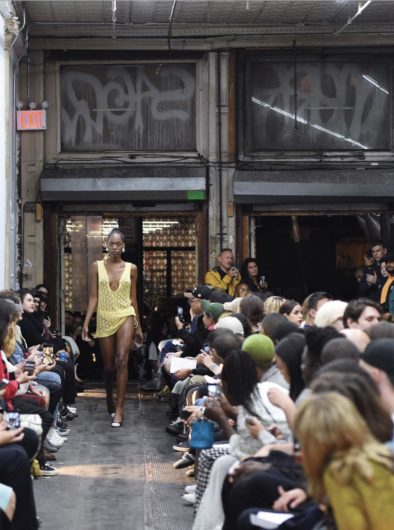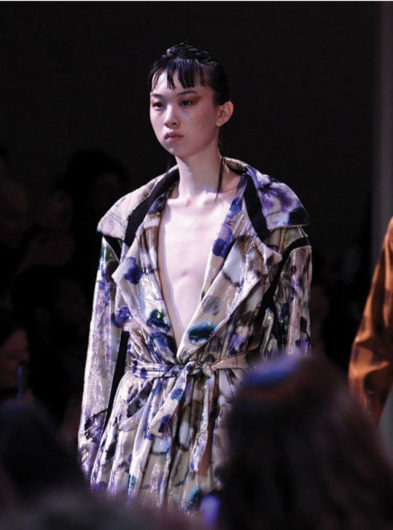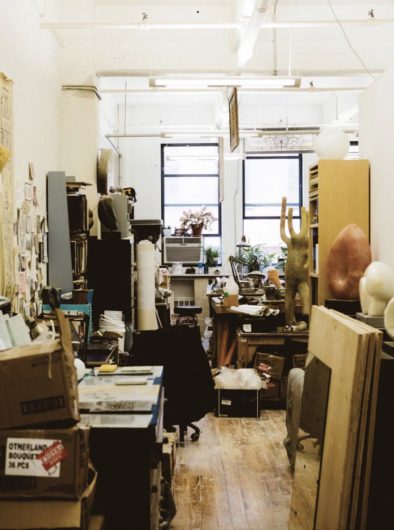New York-based fashion designer Esther Gauntlett often thinks of home when designing collections for her brand Gauntlett Cheng.
Her family, friends, the landscape, homesickness and nostalgia for growing up in Perth play a large part in her designs. “I think fashion has a strange way of transporting you somewhere,” Esther says, “and sometimes that’s somewhere really exotic and sometimes it’s your parents couch.”
Esther’s initial goal when enrolling in fashion design was to gain the skills to sew all the clothes she couldn’t afford at the time – her teenage outfits consisted of lots of ‘scrappy things’ she had
modified or bought from op-shops, paired with low-rise flared jeans.
After bouts of study at Curtin University, Central TAFE and RMIT, Esther set her sights on New York. Here she interned at anti-fashion brand Eckhaus Latta – a design house known for pioneering the use of non-models, encouraging gender fluidity in fashion and preserving the downtown aesthetic. She thrived off the buzz of working for an up-and-coming brand that was on the cusp of breaking through to the big time. Almost all of Eckhaus Latta’s samples were made in-house, which gave Esther the opportunity to understand all the different components of producing a collection.
It is also where Esther met business partner Jenny Cheng. While interning together, they realised they shared the same bursting energy for design. They soon created their own collection, and after a chance showing with mutual friend Patric DiCaprio from Vaquera, they instantly started receiving orders. “If we’d planned any of it out or had been more informed on what was really involved, we would have never done it, so I’m really glad we were so naïve,” Esther says.
After five years in the business, Esther reflects on her favourite Gauntlett Cheng runway presentation – Are You Gonna Cowboy Up or Just Lay There & Die?. Esther laughs at how accurate the name was to how they were feeling at the time. The duo had made the decision to showcase the collection on a boat called Harbour Lights on the East River at sunset, a decision she admits was not the most practical or financially sound, but instead a perfect expression of who they were.

She remembers the boat rocking while INXS’s Never Tear Us Apart played as the show’s soundtrack. That collection challenged the conventions of fashion. Non-models were sent out dressed in deconstructed looks which fused corporate and club attire – think miniscule knitted bikini tops styled with sharp, tailored suit jackets.
Esther’s mother Margaret Dillon, of Mount Lawley’s Concreto, has walked the runway in New York for Gauntlett Cheng on many occasions. For their first ever show, Esther asked her mum to walk, but Margaret needed some convincing.
“I told her that it was important to me, and also hopefully to her, to see people of all ages and body types wear the clothes I make,” Esther says. She has now walked five shows for the brand – more than any other model.
The Spring Summer 2019 collection was inspired by a recent holiday to Maine where they collaborated with friend and artist Bea Fremderman, who created custom buttons from oyster shells collected during their vacation. “It was my first time shucking oysters and it feels so amazing to see that happy memory transformed so literally into pieces of clothing,” Esther says.
In recent years the pressures faced by fashion designers has increased. Instead of two collections a year, the industry has introduced and widely adopted two additional pre-collections – a total of four fresh concepts a year. However, Gauntlett Cheng is swimming against the tide by reducing their offering from two collections per year to just one. They had to sit down and think hard about how they could make their brand last and how to preserve their creative output whilst also considering their work-life balance and the environmental impact.
“I never wanted the label to get swallowed by the fashion industry, which demands more and more of your vision until you end up watering your brand down to something you don’t really care about any more,” Esther says. “I guess we wanted to give ourselves the time and space to make sure we always care about our clothes, that we always love them.”
The Gauntlett Cheng business has been structured to be sustainable with small, locally made, considered collections and a production line manufacturing only to fulfil orders. Esther is determined to remain true to this structure and philosophy, which is increasingly rare in an industry that continues to churn out cheap clothing that despairingly ends up in landfill.
“I wanted to make sure we were only contributing things that we felt really needed to be out in the world – clothes we think are either important for our customers or important for ourselves as people to make.”
Visit – Gauntlett Cheng
@gauntlettcheng – gauntlettcheng.com



